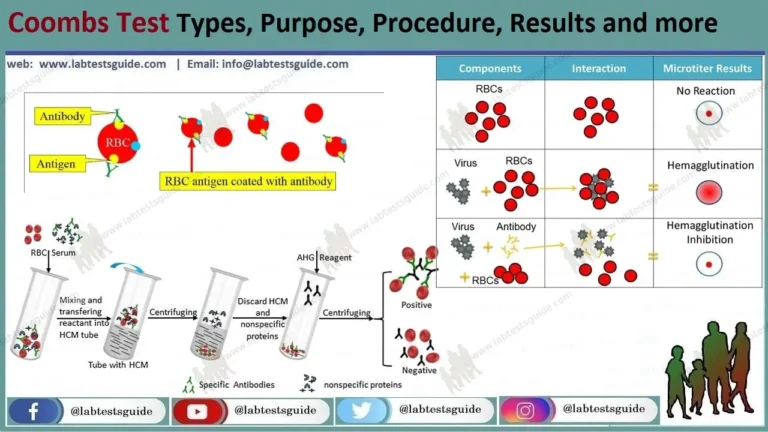If you’ve been feeling fatigued, have shortness of breath, cold hands and feet, and very pale skin, you may have an insufficient amount of red blood cells. This condition is called anemia, and it has many causes.
If your doctor confirms that you have a low red blood cell count, the Coombs test is one of the blood tests your doctor may order to help find out what kind of anemia you have.

Specimen:
Generally clotted or anti-coagulated blood samples may use in Direct Coombs Test and can be tested up to 3 days from the date of collection.
Principle:
Direct Coombs Test is used to demonstrate in-vivo coating (in-vivo sensitization) of red cells with antibodies or complement in particular, IgG and C3d.
Washed red cells from a patient or donor are tested directly with antihuman globulin reagent (AHG). Agglutination that occurs when AHG (antihuman globulin) is added indicates that the specific antibodies are attached (in-vivo) on the red cell antigen.
Procedure:
- Label a test tube according to the lab number and patient’s name.
- Add 1-2 drops of 3 to 5% red cell suspension of patient.
- Add 1-2 drops of antihuman globulin reagent (AHG).
- Mix gently the contents of the tube.
- Centrifuge the tube at 2500 rpm for 20 sec.
- Gently re-suspend the tube.
- Carefully read, interpret and record the result.
Interpretation:
- Agglutination in the test indicates the positive test result, thus the patient’s DAT (direct antiglobulin test) is positive.
- No agglutination in the test tube indicates the negative test result thus patient’s DAT (direct antiglobulin test) is negative.
Important Note:
DAT (direct antiglobulin test) is used in the identification of in-vivo sensitization of red cells. In contrast, for the identification of in-vitro sensitization of red cells, IAT (in-direct antiglobulin test) is used.
Confirmation of Direct Coombs Positive Test:
Introduction:
With the positive result of DAT, the question is, if the agglutination occurred due to AHG (antihuman globulin) reacting with sensitizing IgG antibodies or it was due to spontaneous agglutination by sensitizing IgM antibodies.
To check for this phenomenon, another tube is run in parallel with DAT test tube;
Procedure:
- Label a control tube according to the lab number and patient’s name.
- Add 1-2 drops of 3 to 5% red cell suspension of patient.
- Add 1-2 drops of 6% albumin instead of antihuman globulin reagent (AHG).
- Mix gently the contents of the tube.
- Centrifuge the tube at 2500 rpm for 20 sec.
- Gently re-suspend the tube.
- Carefully read, interpret and record the result.
Interpretation:
- Agglutination in the control indicates the positive result thus the patient’s blood is not positive for DAT and the patient’s RBC are in-vivo sensitized
- No agglutination indicates the negative control result thus patient’s RBC are not sensitized in-vivo, and if DAT test tube showed agglutination, it is true positive.
Important Note:
Both, DAT test and control tubes are run and read in parallel. DAT results are valid only when DAT (6%albumin) control tube is negative;
Confirmation of Direct Coombs Negative Test:
Introduction:
In the case of DAT negative test, a positive control is used to identify the validity of the DAT negative test performed. In true negative case, the added AHG (anti human globulin) antibodies are free and not consumed. When known sensitized cells (check cells) are added to the same tube at the end of the test, free AHG will react with the sensitized cells and facilitate the agglutination.
Procedure:
- Label a test tube according to the lab number and patient’s name.
- Add 1-2 drops of 3 to 5% red cell suspension of patient.
- Add 1-2 drops of antihuman globulin reagent (AHG).
- Mix gently the contents of the tube.
- Centrifuge the tube at 2500 rpm for 20 sec.
- Gently re-suspend the tube.
- Carefully read, interpret and record the result.
- If agglutination does not occur, add 1 to 2 drops of 5% sensitized cells (check cells)
- Mix gently and centrifuge the test tube for the calibrated spin time, gently re-suspend and observe for the agglutination.
Interpretation:
- Agglutination in the tube after addition of sensitized cells (check cells) proves that entire testing of the negative DAT was performed correctly.
- If the agglutination does not occur after addition of known sensitized cells, shows the negative DAT is not valid and the entire test must be repeated.
Important Note:
Known sensitized red cells should be added in the same test tube at the end of the test when result shows negative, since this procedure is used to validate negative test results.
Result:
- It is normally negative, there is no agglutination.
- Positive direct Coombs shows agglutination immediately after centrifugation indicating that RBCs are coated with antibodies.
- This test is read positive when the clumping on a scale of a trace to +4.
- False-positive results are seen in:
- Insufficient washing of the RBCs.
- Over Centrifugation of the test.
- Contaminated reagents.
- If the washed RBCs left for a longer period of time.
The Positive Test Is Seen In:
- Autoimmune hemolytic anemia.
- Warm reactive autoantibody.
- Cold reactive autoantibody.
- Cold haemagglutinin disease is seen in Lymphoma, pneumonia.
- Paroxysmal cold hemoglobinuria.
- Systemic lupus erythematosus.
- Drug-induced hemolytic anemia e.g penicillin, quinidine, Cephalosporin, and α-methyldopa.
- Hemolytic anemia: Transfusion reaction to incompatible RBC and hemolytic anemia of the newborn.
- Erythroblastosis fetalis.
- Incompatible blood transfusion.
- Malignant diseases:
- Lymphoma.
- Chronic lymphocytic leukemia.
- Infections :
- Infectious mononucleosis.
- Mycoplasma pneumoniae.
Related Articles:
Possible References Used






